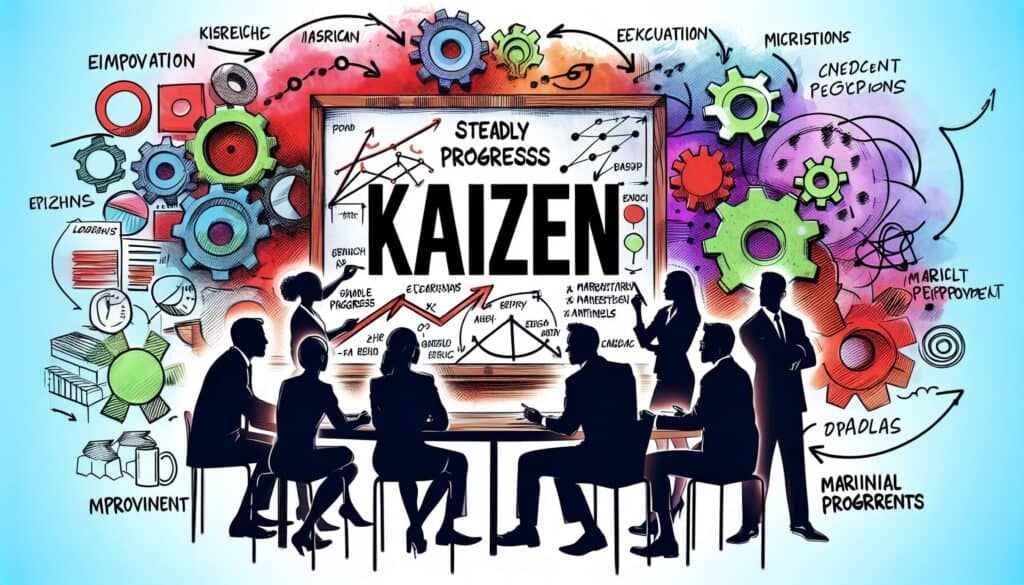A philosophy and practice of making ongoing, incremental improvements to processes, products, and services, involving everyone in an organization.
- Méthodologies : Clients et marketing, Idéation, Conception de Produits
Kaizen (amélioration continue)

Kaizen (amélioration continue)
- Amélioration continue, Kaizen, Production allégée, Planifier, faire, vérifier, agir (PDCA), Amélioration des processus, Optimisation des processus, Assurance qualité, Gestion de la qualité
Objectif :
Comment il est utilisé :
- Involves regular, small-scale improvement activities (e.g., Kaizen events or Blitzes, suggestion systems) where teams identify waste or inefficiencies, brainstorm solutions, implement changes, and standardize successful improvements. Focuses on PDCA cycles.
Avantages
- Promotes a culture of continuous learning and employee engagement; Leads to gradual but significant long-term improvements; Low cost, often focusing on creativity over capital investment; Improves efficiency and reduces waste.
Inconvénients
- Requires strong management commitment and supportive culture; Can be slow to achieve radical changes if only small steps are taken; Sustaining momentum can be challenging; May faceresistance from employees accustomed to traditional ways.
Catégories :
- Idéation, Lean Sigma, Fabrication, Résolution de problèmes, Gestion de projet, Qualité
Idéal pour :
- Fostering a culture of ongoing, incremental improvements across all aspects of an organization to enhance quality, efficiency, and employee satisfaction.
Kaizen is frequently applied across various industries including manufacturing, healthcare, and service sectors, where continuous improvement can significantly enhance operational effectiveness. During the development phase of a product, teams can initiate Kaizen events or Blitzes, bringing together cross-functional groups to identify specific areas of waste or inefficiency within processes. For instance, in a manufacturing setting, Kaizen might focus on optimizing assembly line procedures through small adjustments that minimize downtime or eliminate redundant steps. Healthcare facilities often employ Kaizen to improve patient flow and resource allocation, allowing staff to devise solutions that enhance care delivery without necessitating substantial budget increases. Participating team members may include engineers, quality control experts, frontline staff, and management, all of whom contribute their unique perspectives and expertise to the problem-solving process. The use of PDCA (Plan-Do-Check-Act) cycles enables teams to systematically implement improvements, monitor the impact, and standardize successful changes. These methodologies can lead to a culture where employees feel empowered to suggest ongoing refinements, ultimately engendering a sense of ownership and commitment to achieving excellence within the organization. As improvements accumulate over time, the results can transform operational capabilities, increase customer satisfaction, and promote a sustainable environment where continuous learning becomes integral to the organization’s ethos.
Principales étapes de cette méthodologie
- Identify areas of improvement through collaboration and observation.
- Brainstorm potential solutions for identified inefficiencies.
- Implement selected improvements on a small scale or in pilot tests.
- Standardize successful changes to ensure consistent application.
- Review the effects of implemented changes and gather feedback.
- Repeat the cycle to continuously seek further enhancements.
Conseils de pro
- Incorporate cross-functional teams in Kaizen events to leverage diverse perspectives and enhance problem-solving capabilities.
- Use data analytics to identify specific areas of waste and inform decision-making during improvement initiatives.
- Establish a robust feedback loop post-implementation to evaluate the long-term impact of changes and continually refine processes.
Lire et comparer plusieurs méthodologies, nous recommandons le
> Référentiel méthodologique étendu <
ainsi que plus de 400 autres méthodologies.
Vos commentaires sur cette méthodologie ou des informations supplémentaires sont les bienvenus sur le site web de la Commission européenne. section des commentaires ci-dessous ↓ , ainsi que toute idée ou lien en rapport avec l'ingénierie.
Contexte historique
1950
1980
1980
1986
1994
1995
2000
1960
1980
1983
1990
1995
2000
2010
(si la date est inconnue ou n'est pas pertinente, par exemple "mécanique des fluides", une estimation arrondie de son émergence notable est fournie)














Articles Similaires
Gestion des opérations de fabrication (MOM)
Système d'exécution de la fabrication (MES)
Plan de contrôle de la fabrication
Tests manuels
Tableaux d'évaluation des manutentions manuelles (MAC)
ManTRA (outil d'évaluation des risques liés aux tâches manuelles)